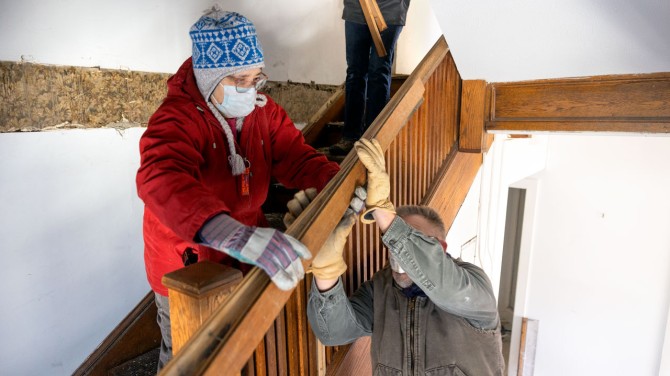Jobs
Deconstruction, Reuse Boost NY Jobs, Climate

Shifting from wasteful demolition practices to a circular construction economy in New York state could unlock unrealized economic activity, create thousands of green jobs and advance ambitious climate goals – while reducing pressure on landfills, Cornell experts report in a new white paper that aims to inform proposed state legislation.
Published Oct. 3, “Constructing a Circular Economy in New York State: Deconstruction and Building Material Reuse” provides policymakers, state agencies and local governments with a roadmap for transitioning from today’s “take-make-waste” linear construction paradigm to one that prioritizes the systematic deconstruction of buildings and the reuse of materials that retain substantial value, along with their embodied carbon.
According to the researchers’ analysis, converting half to three-quarters of residential building demolitions to deconstructions would have a direct economic impact of $872 million to $1.4 billion; create between 8,130 and 12,630 jobs; and reclaim 270,000 to 420,000 tons of materials for reuse – “all of which could foundationally reshape an entire sector of the New York state economy,” they write.
Dozens of volunteers salvaged original wood flooring, utilities and other elements from the 11 homes being taken down at the Catherine Commons site in 2022.
Reviewing data and best practices from across the country, the white paper offers 19 policy and practice recommendations for developing the workforce, market and infrastructure needed to establish New York as a circular economy leader.
“Relative to demolition and landfilling, deconstruction and reuse create considerably more economic, environmental and social value, and can be instrumental in achieving New York state’s economic and climate goals,” said Felix Heisel, assistant professor of architecture and director of the Circular Construction Lab in the College of Architecture, Art and Planning (AAP).
“A shift to a circular construction economy is not only a matter of environmental sustainability, it is an economic and social imperative for New York state,” added Jennifer Minner, associate professor of city and regional planning and director of the Just Places Lab in AAP.
Wyeth Augustine-Marceil, MRP ’23, a research associate in the Circular Construction and Just Places labs, acted as project lead for the white paper.
A focus on the built environment is essential to achieving New York state’s climate goals, outlined in the 2019 Climate Leadership and Community Protection Act; the 2022 executive order, “Leading by Example: Directing State Agencies to Adopt a Sustainability and Decarbonization Program”; and the Department of Environmental Conservation’s 2023 solid waste management plan, according to the researchers.
Buildings and waste are the first- and fourth-largest greenhouse gas-emitting sectors in New York state, responsible for 43% of annual emissions, according to the authors. Of the more than 18 million tons of construction and demolition (C&D) debris the state produces annually – nearly half of all waste generated – 7.7 million tons comes from buildings, of which nearly 60% is landfilled, burned or exported. That volume will soon pose an even greater challenge with the two largest C&D landfills – in Brookhaven, on Long Island, and upstate in Seneca Falls – scheduled to close or stop accepting C&D by the end of 2025.
Demolition and landfilling have benefited from low upfront costs that do not account for the long-term costs of landfills, emissions and health impacts that disproportionately affect vulnerable communities. But up to 90% of building materials can be reused or recycled, and 80% of what is landfilled – from wooden and steel structural beams to floorboards or fixtures – still holds economic value, representing a “massive untapped opportunity,” according to the white paper.
To realize that potential, the experts’ recommendations seek to improve data collection; foster a robust market for reused materials; leverage the state’s purchasing power; and encourage local policy adoption and targeted workforce development.
New York State Assemblymember Anna Kelles (D-125th District) said there is urgency to act with the state’s municipal solid waste landfills nearing capacity within a quarter-century, and to help mitigate supply chain disruptions like those experienced during the pandemic.
Kelles said the independent, comprehensive white paper would help her draft related legislation, including proposing templates and incentives for local deconstruction ordinances and resolutions, like one adopted recently by the City of Auburn; workforce training; infrastructure for storing reusable building materials; and an online materials marketplace.
“This white paper both provides a strategic blueprint and highlights existing legislation across the country that, when adopted concurrently in New York, will establish a sufficient quality building supply, an accessible marketplace, a trained workforce and supportive policies to establish a robust circular economy,” Kelles said. “Given the state of climate change and instability in global supply chains that it can and will cause, we need to move quickly, and this is too important not to get right.”
In addition to Augustine-Marceil, Heisel and Minner, the white paper’s co-authors include Diane Cohen, CEO of Finger Lakes Reuse, and Gretchen Worth, MPS ’19, M.A. ’20, project director at the Susan Christopherson Center for Community Planning, all members of the Circularity, Reuse, and Zero Waste Development (CR0WD) network. CR0WD will host a virtual discussion about the white paper on Oct. 7.
The multidisciplinary research team also included Denise Ramzy, senior lecturer in the Charles H. Dyson School of Applied Economics and Management, part of the Cornell SC Johnson College of Business; Lori Leonard, professor and chair of the Department of Global Development in the College of Agriculture and Life Sciences; Just Places Lab researchers Courtney Bower, MRP ’21, a doctoral student in the field of regional science, and Junbo Huang, M.S. ’23; Circular Construction Lab researchers David Perovsek, M.Arch. ’26 , and Roma Patel ’28; from CR0WD, Kai Foti ’24 and Annie Stewart ’25; and Brad Guy, owner of Material Reuse LLC.
The research was supported by The 2030 Project, a climate initiative within the Cornell Atkinson Center for Sustainability.











